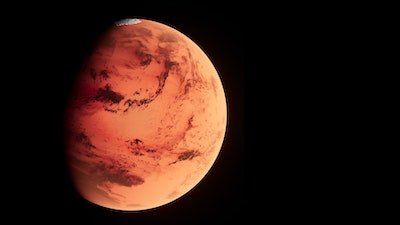
Ice Caps on the Equator (of Mars)
National Geographic News: “Weird Mars Deposits Could Be Vast “Ice Cap” at Equator” The existence of water on Mars is once again on scientists’ minds, this time because of new high-resolution radar images of the red planet.
Researchers led by Thomas Watters of the Smithsonian Institution’s National Air and Space Museum pored over radar images of the martian surface and found similarities between deposits near the equator and sediments at the ice-covered poles. The properties of the deposits have the researchers wondering if they could possibly be ice.
The other possibility, according to Watters, is that the deposits are “dry, low-density materials.”
The radar images show the deposits to be “highly porous.”
The deposits, located in the equatorial plateaus known as the Medusae Fossae Formation, have puzzled researchers for decades, reports National Geographic News. The radar images show the deposits to be “highly porous,” meaning
they could be pure ice protected by a meters-thick blanket of sediments or that they are made of an airy, pumicelike substance.
Watters also notes that the electrical properties of the deposits “were so similar to [those of] polar layered deposits that are known to be ice rich."
Astrogeologist Kenneth Tanaka of the U.S. Geological Survey finds the idea surprising. “It would be like finding evidence of ice caps on Earth at the Equator . . . [i]t's kind of very strange.”
According to Tanaka, though, the deposits “don't look much like the polar layered deposits morphologically.” Furthermore, Watters and his colleagues say that either volcanic ash or “wind-blown deposits” could create material porous enough to be mistaken for ice. The problem is there are no volcanoes nearby that might account for volcanic ash.
Of course, it’s easy to understand why some scientists are excited about this icy prospect. National Geographic News notes that, “If the equatorial plateaus do contain lots of ice, they could hold as much water as the red planet’s south pole”; Watters adds what every evolutionist must be thinking—“an icy equator would mean that ‘it is not impossible that [the plateaus] could harbor some form of life.’”
The idea of Martian life has invigorated discussions of extraterrestrial life for centuries. There’s certainly no indication that the lack of life found there so far has dampened evolutionists’ hopes that we will find it there some day. Of course, with each new, fevered claim that there could be life-harboring water on Mars—and with each quiet dismissal of such hypotheses—we grow increasingly confident that evolutionists are placing their faith at odds with all the evidence. It wouldn’t be the first time!
For more information:
Remember, if you see a news story that might merit some attention, let us know about it! (Note: if the story originates from the Associated Press, Fox News, MSNBC, the New York Times, or another major national media outlet, we will most likely have already heard about it.) And thanks to all of our readers who have submitted great news tips to us.
(Please note that links will take you directly to the source. Answers in Genesis is not responsible for content on the websites to which we refer. For more information, please see our Privacy Policy.)

Answers in Genesis is an apologetics ministry, dedicated to helping Christians defend their faith and proclaim the good news of Jesus Christ.
- Customer Service 800.778.3390
- Available Monday–Friday | 9 AM–5 PM ET
- © 2025 Answers in Genesis



